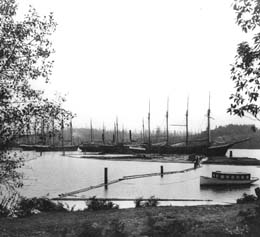In 1878, Madrone's first homesteaders, Riley and Martha Hoskinson and their children, arrive at Eagle Harbor on the southeast side of Bainbridge Island. The island is located in central Puget Sound directly west of Seattle in Kitsap County. The Hoskinsons claim 160 acres near a creek on the site where downtown Winslow (later renamed Bainbridge Island) will stand. Riley Hoskinson is a devout Congregationalist and will help found Eagle Harbor Congregational Church, the island's first church, in 1882.
Observing Weather, Clearing the Land
Riley Hoskinson served in the Civil War and the family had lived in Kansas and San Francisco and on Smith Cove in Seattle before settling at Eagle Harbor. From 1878 until 1889 he used instruments mounted on his roof to record the first weather observations for the area west of the Mississippi. In his role as a "voluntary observer" he sent reports to Washington, D.C.
Hoskinson promoted Bainbridge Island in an article for a New York newspaper. The article found its way into the hands of Ambrose Grow, who lived just outside Manhattan, Kansas. Like Hoskinson, Grow had served in the Civil War and belonged to the Congregational Church. Grow gathered his family and moved to Bainbridge Island in 1881, claiming the homestead next to the Hoskinsons’.
A Farming Community
Unlike other towns on the island, Madrone was not a company town. The Hoskinsons and Grows, like many who followed them, primarily farmed for a living, providing for their families’ subsistence and growing fruits, vegetables, flowers, and livestock for sale to other settlers and in Seattle.
The town grew slowly to include more homesteads and some small businesses.
In 1890 a post office opened and the area was named Madrone. The town drew its
name from a madrone (or madrona) tree growing by the Madrone grocery. By 1900 there were a couple of grocers, a steamer dock, and a number of farms.
Trees hindered farming and clearing them required extensive labor. Japanese immigrants who had worked in the island's sawmills were hired to clear land. In exchange, they were paid and sometimes allowed to use portions of the cleared land for their own crops. In this way, the island's strawberry farms were established and a large Japanese American community developed on the island.
In 1903 the town's name changed to Winslow, in honor of Winslow Hall, one of the founders of Hall Brothers Shipyard, who had recently died. In 1947 Winslow incorporated.
In the mid- to late-twentieth century the once-thriving farms lost ground due both to population increases and to the disruption caused by Japanese American internment during World War II. Easy access to the mainland via Agate Pass Bridge and the ferry to Seattle made the island attractive for residential development.
In 1990 Winslow annexed the entire island, and in 1991 the name changed to Bainbridge Island.

